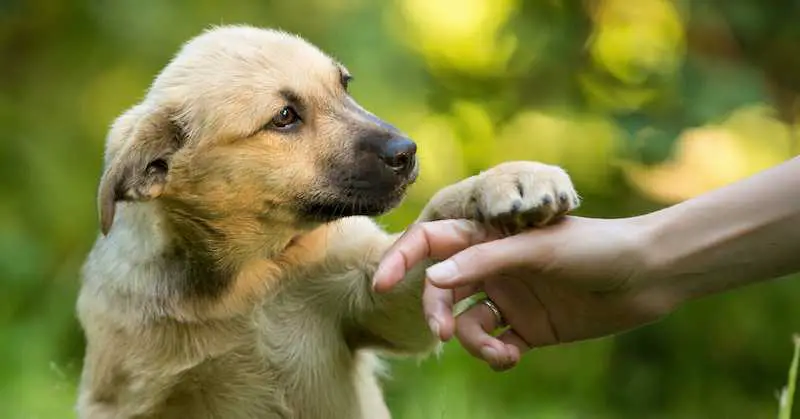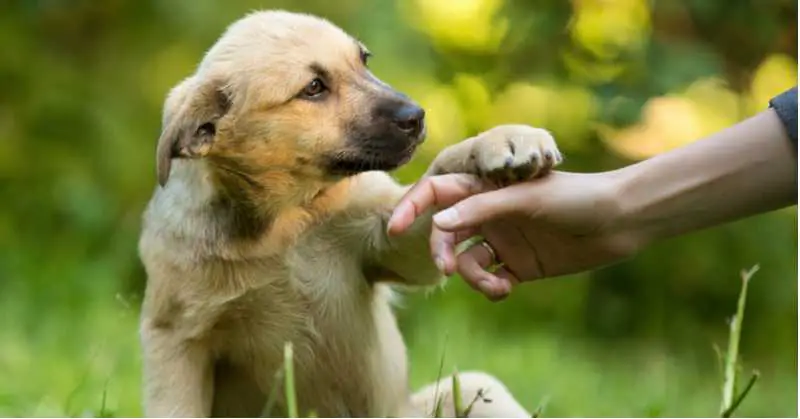
There is a question making the rounds among dog lovers…What does it mean when your dog paws you? We are not talking a high five with your dog or a response when asked to shake hands. We’re talking about when your dog reaches out and gently touches you, usually with a seriously sweet and somewhat pleading look in its eyes.
People seem to fall into a couple of camps on this question: those who think it is an act of dominance, those who think it is just another way of begging, and those who think your pup is asking for affection.
They Are Trying to Show You Who Is Boss
Karen Soukiasian, a longtime dog trainer writing for Dog’s Best Life, suggests that if your pooch “continues to paw you and ignores your commands to stop, your dog may be trying to boss you around. Try walking away from your dog or turning your back on him. Ignoring your dog will teach him that pawing or scratching you is unacceptable behavior.”1 It may take a few encounters like this to reinforce who’s boss, and Karen reminds us that we need to be patient and always positive.
They Are Pleading for Something They Want
Mikkel Becker, the resident trainer at Vetstreet, feels that pawing is a dog’s equivalent of a young child repeating “Mom, Mom” until it gets attention, or in a dog’s case getting something it wants like being let outside or getting a treat. Becker tells the story of a pawing Shih Tzu with a taste for treats that “trained my grandma to act like a vending machine.”2 For people who want to discourage such behavior, Becker suggests training the dog into a desirable behavior, like teaching the dog to use a “potty bell.”
For those of us who have never heard of a potty bell, Nat Geo is kind enough to offer this video.
The Bell Training Technique from Nat Geo WILD’s Puppy Days series.
They Are Demonstrating Submission
Pat Miller, Training Editor for the Whole Dog Journal gives some great background on how to read dog gestures that have been studied and categorized by the noted Norwegian dog trainer, Turid Rugaas. Explaining that as pack animals, dogs have evolved to show nonthreatening behaviors in order to keep the peace among the animals they live with, pawing falls into a group of behaviors that broadcast calming signals to communicate appeasement or active submission. 4
Miller says that “While uncontrolled pawing behavior can be annoying, a simple paw lift is a lovely behavior.” She suggests that “persistent, annoying pawing is best extinguished by ignoring the behavior” or owners can train the dog to change from pawing to a behavior that can’t be done while pawing like obeying a command to place all four of its feet on the floor. 4
They Are Saying “I Love You!”
Rebecca Forrest, writing on dog behavior for The Dog Clinic, has this take on pawing: “Studies have shown ‘feel good’ hormones such as oxytocin are released by both human and dog during a petting session. By putting his paw on you whilst you are stroking him, he is further extending contact and reciprocating affection back.” 5 A writer for People magazine summarized Forrest’s thoughts nicely saying, “If your dog starts pawing you while you’re already showing them some love, it could be their way of returning the favor.”6
Now that you have a better idea of what your pooch is communicating with a paw, take a moment to watch whether your pet is using its right or left paw. It turns out that dogs have a paw preference, just like their right- and left-handed humans.7 Researchers at the University of Sydney looked for traits that might help identify dogs that were likely to have a better probability of graduating from a Guide Dog training program and found that right-pawed dogs had a higher success rate. 8
Of course, much more research will be needed to understand the links between personality, behavior, and paw preference. For now, it seems like good news to think that your dog’s preference to paw with either foot might be a sweet sign of love.
References
1Soukiasian KA. Dog Behavior: Understand Pawing. 26 November 2019. Dog’s Best Life. https://dogsbestlife.com/home-page/dog-behavior-understand-pawing/
2Becker M. 5 Tips on How to Stop a Dog from Pawing. 28 March 2014. Vetstreet. http://www.vetstreet.com/our-pet-experts/5-tips-on-how-to-stop-a-dog-from-pawing
4Miller P. Understanding Dog Appeasement Signals. 7 March 2006 (Updated 22 April 2019). Whole Dog Journal. https://www.whole-dog-journal.com/behavior/understanding-dog-appeasement-signals/
5Forrest R. Why Does My Dog Put His Paw on Me? The Dog Clinic, Dog Behavior. https://www.thedogclinic.com/why-does-my-dog-put-his-paw-on-me
6Pasquini M. When Dogs Paw You, They could Be Trying to Express How Much They Love You. 5 December 2019. People. https://people.com/pets/what-does-it-mean-dogs-paw-you/?utm_source=facebook.com&xid=socialflow_facebook_peoplemag&utm_campaign=peoplemag&utm_medium=social&fbclid=IwAR1FkB0qrmyU-bwA7As2yNB4HyWZEmNZzlZj0G8TNwlgL148bmLxEJSLq4c
7Gibeault S. Is Your God Right- or Left-Pawed? AKC Expert Advice Section. AKC.org. 13 December 2017. https://www.akc.org/expert-advice/lifestyle/dog-right-or-left-pawed/
8Tomkins LM, Tomson PC, McGreevy PD. Associations between motor, sensory and structural lateralization and guide dog success. The Veterinary Journal 2011; 192(3): 359-67. https://www.researchgate.net/publication/51739114_Associations_between_motor_sensory_and_structural_lateralisation_and_guide_dog_success
VIDEO. Nat Geo Wild. Puppy Days: The Bell Training Technique. 12 January 2017. https://www.youtube.com/watch?v=me0mKBhz7D4
